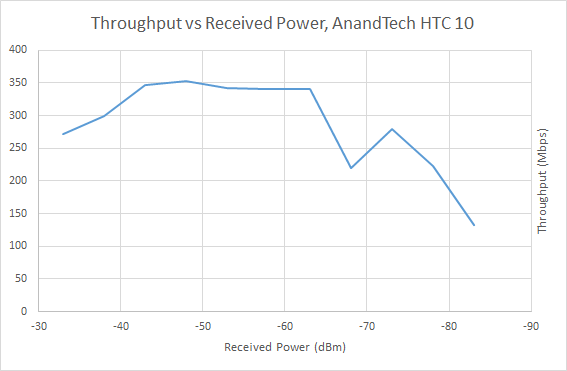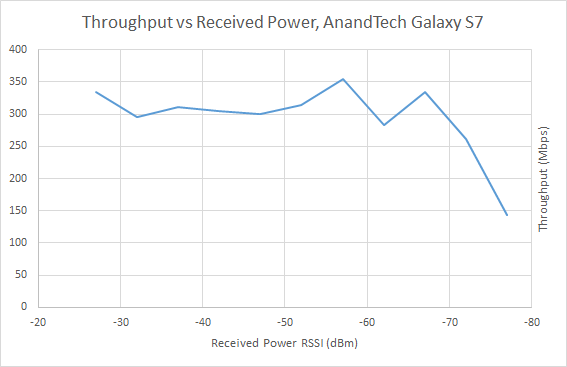The Samsung Galaxy S7 and S7 edge Review: Part 2
by Joshua Ho on July 5, 2016 8:00 AM ESTWiFi Testing with Ixia IoT
As previously discussed, RF testing has always been a major unknown to some extent because environmental factors make it extremely difficult to tell exactly what is going on with the system. I don’t think it really needs to be said but previous reviews and any controversy regarding the quality of RF has always lead to a ring of confusion and back and forth with no clear-cut answers, at least in the public domain. The Transformer Prime and Pixel C reception issues have all been cases where I’ve seen a lot of confusion over whether a problem really existed in the hardware, software, or with the end user.
Most people really don’t have any understanding of how wireless transmission works, probably because it’s not really something you can see. As far as I know, no one is capable of seeing radio waves, even at high frequencies like 60 GHz. Of course, the problem is that for quite some time our testing was also not really ideal for seeing the quality of an RF implementation. While iPerf does provide some useful data, free space testing means that we’re dealing with channel conditions that inherently cannot be controlled. As a result, the only sensible test we could do with iPerf was focus on maximum throughput in the best conditions we could provide. The only thing that this can highlight is the upper bound of efficiency for WiFi due to the carrier sense multiple access scheme in most cases, and rarely detects a whole class of problems that affect user experience on WiFi.
In order to test these things we’ve moved to using a proper testing system that is actually used by at least a few OEMs today, namely Ixia IoT. While we discussed the possibilities for testing, at this time due to the RF isolation chamber used we are limited to AP simulation only, so we can’t properly simulate clients in the channel without restricting ourselves to a single spatial stream for both the AP and client. This wouldn’t be a very useful test if set up in this manner as most devices today that we’re testing have support for two spatial streams, and many routers have three or even four spatial streams at this point.
The first set of results we can talk about that will be of interest is rate vs range. This is a fairly simple test at a conceptual level, as it simply tries to see how well a device can maintain its performance in the face of reducing signal to noise ratio for a given modulation and coding scheme. This is a good high level test of how well a device can maintain a connection as reception degrades. In this test the HTC 10 had an initial RSSI of -28 dBm while the GS7 was at -21 dBm and the iPhone 6s at -22 dBm, which allows us to calculate the path loss and determine the RSSI as a function of the transmit power.
The results of this test are interesting to say the least. Off the bat, every device had different RSSIs measured, so this meant that everything had different levels of path loss. The HTC 10 seemed to have the most path loss, while the Galaxy S7 and iPhone 6s were functionally identical. However it looks like RSSI is really an insufficient metric here because while the iPhone 6s was able to reach maximum throughput using NSS 2 MCS 8, the HTC 10 and Galaxy S7 did its best at NSS 2 MCS 4 or 5. I suspect this may be just due to placement as device positioning strongly affects MIMO as receive-side spatial correlation reduces the gains that MIMO can provide. Regardless, the HTC 10 somehow manages to beat the Galaxy S7 through much of the curve, but for some reason suffers from a reduction in throughput at higher transmit power. It's worth mentioning though that this test doesn't allow for testing of antenna gain or similar tests. Given various levels of futzing about with the device positioning in the test chamber I'm fairly confident that the Galaxy S7 is consistently better with regard to path loss, so even if it doesn't perform as well at a given RSSI it tends to have a higher RSSI than the HTC 10 by about 5 dBm which is fairly significant.
Finally, the other test that we can run at this time is the roaming latency test, which tests how well a device can hop from one access point to another as the received transmit power rises and falls. If you ever rely on WiFi to work as you walk around any building larger than a single apartment unit, you’re going to feel the effects of high roaming latency as VOIP calls or any real-time network application will either experience interruption or drop altogether if roaming is not implemented properly.

In the case of the Galaxy S7, roaming latency is honestly rather wanting. In the best case the Galaxy S7's roaming latency appears to be acceptable, but it's still significantly worse than the best we've seen so far. It seems that Samsung's algorithms have issues with edge cases as I've seen multiple instances so far where the device just can't handle roaming consistently. Despite consistent positioning and identical test setup I've seen cases where the Galaxy S7 has problems with consistent roaming. Even with the simple case of 10 dBm to -45 dBm at 3 dBm drop per second, I've encountered weirdness where the device drops from the network altogether claiming that the password given was incorrect (it wasn't) or a few successful handovers followed by getting stuck on a single access point or dropping from the network entirely. Even in the best set of trials performed I still saw 3 of 64 trials fail to roam correctly. The performance is certainly far better than something like the Google Pixel C, but Samsung should really be focusing on improving here.













266 Comments
View All Comments
sevenmack - Wednesday, August 10, 2016 - link
Not for me and not for many people who buy phones on contract. My two-year contracts usually end in October, months after many phones are released. Knowing how well phones are peforming out of the box matters no matter when they come out. So the review is timely for many of us out there.Additionally, as I have experienced latelywith two LG G4s dying bcause of motherboard issues, you may find yourself in the market for a new phone at an unexpected time. Again, the review is timely for me and for other people.
Finally: Testing a phone properly takes time. The reality is that the reason that so many other outlets released their reviews so quickly is because they aren't doing much of anything to put the phones through the paces. The average smartphone review is shallow, superficial and uttlerly devoid of objective data.
Anandtech does it differently -- and I appreciate that. You may not. That's your problem and you can take your eyeballs elsewhere.
virtuastro - Tuesday, July 5, 2016 - link
Front Camera Aperture Size is F/1.7 not F/2.2. Might be typo. Or maybe is it on international phone? Anyway not bad review but I still keep my GS6 for great camera at low-light no pixels issue just a bit over-saturated but it can be do quick editing.hans_ober - Tuesday, July 5, 2016 - link
No Soc /Exynos deep-dive?JoshHo - Wednesday, July 6, 2016 - link
It should be coming but I'm not sure when Andrei will finish it.Mark W 52 - Tuesday, July 5, 2016 - link
Read this article about these two phones, your conclusions and characterized poor battery of the Nexus 6P is definitionally NOT CONSISTENT with the findings of this other write up.
http://www.androidcentral.com/samsung-galaxy-s7-ed...
Mark W 52 - Tuesday, July 5, 2016 - link
I would definitely rather have and recommend a "pure vanilla Android experience" over the bloated touch wiz skin that Samsung puts on their phones. I had an old S3, and had to drop it over two years ago when it couldn't be updated and got stuck on 4.3 Android. Samsung and T-MOBILE could not agree on the terms and conditions even though Google told me that the the phone could have gone to 4.42. And, Samsung takes forever to update their devices. On the other hand, updates from Google have recently been monthly. Big difference,. I'm sticking with Google phones from now on.fanofanand - Wednesday, July 6, 2016 - link
The monthly updates are security updates. Important, no doubt, but they are not OS updates. I would never buy a non-Nexus phone because I value the security updates as well as the OS updates, but don't be confused on what is being updated.erple2 - Wednesday, July 6, 2016 - link
True, but the security updates are actually the important ones. OS updates are nice and all, but the reason I've been nexus only since the Nexus 4 is for security updates.InspectHerGadget - Sunday, July 31, 2016 - link
I agree. I think waiting for the latest OS update is frustrating. The fragmentation of Android is a major issue especially if you are waiting for a bug fix. I had one on my Note 5 on the photo app where it went into the digital zoom rather than taking the photo. I had to close then reopen the camera app before I could take the photo. It did this only occasionally but often enough just the same.pav1 - Tuesday, July 5, 2016 - link
This review is too late. Too darn late, to be precise. I bought the s7 for the camera and am disappointed.